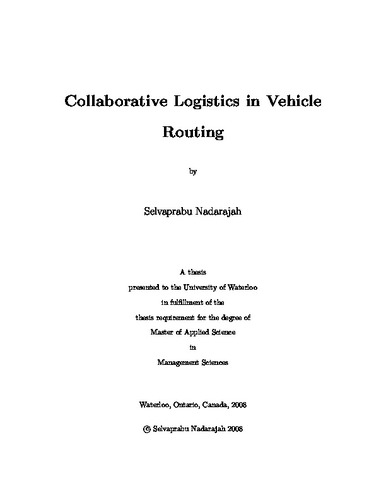| dc.description.abstract | Less-Than-Truckload (LTL) carriers generally serve geographical regions that are more localized than the inter-city routes served by truckload carriers. That localization can lead to urban freight transportation routes that overlap. If trucks are traveling with less than full loads there may exist opportunities for carriers
to collaborate over such routes. That is, Carrier A will also deliver one or more
shipments of Carrier B. This will improve vehicle asset utilization and reduce asset-repositioning costs, and may also lead to reduced congestion and pollution in cities.
We refer to the above coordination as “collaborative routing”.
In our framework for collaboration, we also propose that carriers exchange goods at logistics platforms located at the entry point to a city. This is referred to as “entry-point collaboration”. One difficulty in collaboration is the lack of facilities to allow transfer of goods between carriers. We highlight that the reduction in pollution and congestion under our proposed framework will give the city government an incentive to support these initiatives by providing facilities. Further, our analysis has shown that contrary to the poor benefits reported by previous work on vehicle routing with transshipment, strategic location of transshipment facilities in urban areas may solve this problem and lead to large cost savings from transfer of loads between carriers.
We also present a novel integrated three-phase solution method. Our first phase uses either a modified tabu search, or a guided local search, to solve the vehicle routing problems with time windows that result from entry-point collaboration. The
preceding methods use a constraint programming engine for feasibility checks. The second phase uses a quad-tree search to locate facilities. Quad-tree search methods
are popular in computer graphics, and for grid generation in fluid simulation. These methods are known to be efficient in partitioning a two-dimensional space for storage and computation. We use this efficiency to search a two-dimensional region and locate possible transshipment facilities.
In phase three, we employ an integrated greedy local search method to build collaborative routes, using three new transshipment-specific moves for neighborhood definition. We utilize an optimization module within local search to combine multiple moves at each iteration, thereby taking efficient advantage of information from neighborhood exploration. Extensive computational tests are done on random data sets which represent a city such as Toronto. Sensitivity analysis is performed on important parameters to characterize the situations when collaboration will be beneficial. Overall results show that our proposal for collaboration leads to 12% and 15% decrease in route distance and time, respectively. Average asset utilization is seen to increase by about 5% as well. | en |

